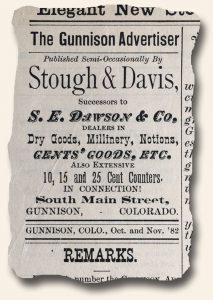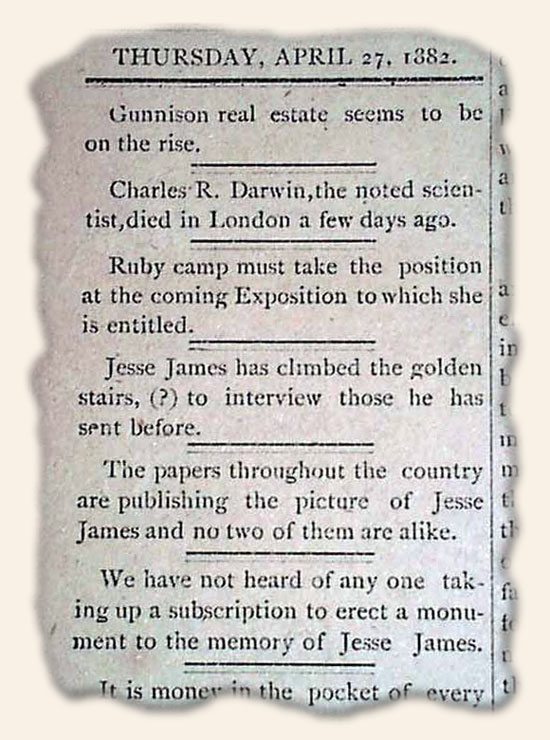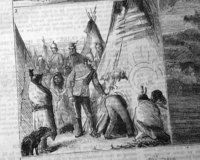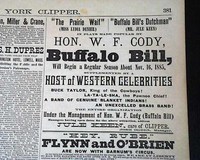“Just a Moment Before”… The Wild West is Romanticized…
September 2, 2024 by Laura Heilenman · Leave a Comment

Our lives are filled with “Just a Moment Before” instances – the brief seconds, minutes, or day right before we hear either good or bad news which changes our lives forever. From dramatic events to small, nuanced changes, our life’s path is littered with turning points. On July 26, 1881, a newspaper editor set about his daily work of printing the day’s news in THE TOMBSTONE EPITAPH, without any inkling of what he would be printing exactly 3 months later.
“Few could argue for a more recognizable title from the Old West, nor could any town be more linked to the romance of the West than this one. Tombstone is steeped in Western lore, and the several movies done concerning the gunfight at the O.K. Corral have kept this town in popular culture.” ~ Tim Hughes
But on this July day, the editor only gave brief mention to the Earp brothers, with a page 3 legal notice for a mining claim beginning: “United States Land Office…Notice is hereby given that Robert J. Winders for himself and his co-claimants, Virgil W. Earp, Wyatt [misspelled at Eyatt] S. Earp, and James C. Earp, whose post office address is Tombstone, Cochise county…”
Little did he know that just 3 short months later he would be printing a defining moment in the epic drama of the United States’ Wild West era.
Sheriff Pat Garrett… the killer of Billy the Kid…
January 9, 2017 by TimHughes · 2 Comments
It was a surprise when I opened an 1884 issue of the “St. Louis Globe-Democrat“ to find a print of Pat Garrett, the noted sheriff of Lincoln County, New Mexico, who: “…did the world a great service in ridding it of Billy the Kid, the most cold-blooded and cruel desperado of modern times…” as the article notes. Never before have I seen a print of Garrett in any periodical. Is anyone aware of an earlier print, or any print of him from any date?
This issue is from over 3 years after he killed Billy the Kid, his likeness appearing in the newspaper because he attended a convention of cattlemen held in St. Louis at this time.

Second time killed was the charm…
December 26, 2016 by TimHughes · Leave a Comment
The April 8, 1882 issue of the “Garfield Banner” from Tin Cup, Colorado, has an interesting article on the front page reading: “Jesse James has been killed again. This time a member of the gang named Bob Ford, a cousin of Jesse, is the man who killed him. Ford had been with Jesse about a week seeking an opportunity to kill him,and finally shot him in the back of the head, the ball coming out over his left eye.”
They should have published why the first time he was killed it didn’t work.
Perhaps one of Gilligan’s ancestors… What does it mean?
November 28, 2016 by TimHughes · Leave a Comment
 An issue of “The Gunnison Advertiser” from Colorado, 1882, notes that it is: “Published Semi-Occasionally…”. Just what does this mean? If “occasionally” means it is not on any set schedule–printed at the whim of the publisher–how much more defining is “semi-occasionally”?
An issue of “The Gunnison Advertiser” from Colorado, 1882, notes that it is: “Published Semi-Occasionally…”. Just what does this mean? If “occasionally” means it is not on any set schedule–printed at the whim of the publisher–how much more defining is “semi-occasionally”?
Just curious. Any ideas?
They put it in print… Jesse James’ belongings auctioned at “high” prices…
December 14, 2015 by TimHughes · Leave a Comment
Collector interest in the personal effects of the famous and infamous is certainly strong, with news noting auctions of noted personalities reporting surprising high bids.
 This is not a recent phenomena. The “St. Louis Globe-Democrat” of April 11, 1882, contains a front page report headed: “Jesse James Relics” which reports on an auction of household goods at the home of the infamous bandit who was killed just 8 days prior. Interest in his personal effects was high, with the report noting in part: “…The crowd began assembling at noon…several thousand people had gathered about the house. The goods sold were of little or not value, yet a large sum of money was realized. Six plain cane-bottom chairs sold for $2 each, and the one on which the outlaw was standing when he received the fatal bullet sold for $5…an old revolver, $17; washstand, $11…The entire lot would not, only for the name, be worth $10, but nearly $200 was realized…”.
This is not a recent phenomena. The “St. Louis Globe-Democrat” of April 11, 1882, contains a front page report headed: “Jesse James Relics” which reports on an auction of household goods at the home of the infamous bandit who was killed just 8 days prior. Interest in his personal effects was high, with the report noting in part: “…The crowd began assembling at noon…several thousand people had gathered about the house. The goods sold were of little or not value, yet a large sum of money was realized. Six plain cane-bottom chairs sold for $2 each, and the one on which the outlaw was standing when he received the fatal bullet sold for $5…an old revolver, $17; washstand, $11…The entire lot would not, only for the name, be worth $10, but nearly $200 was realized…”.
Can you image what these Jesse James belongings would sell for today? A revolver (the one noted above?) owned by Jesse James was in a Heritage auction in 2013 & was expected to bring $1.6 million. It did not sell.
Interesting comments on Jesse James…
June 6, 2014 by TimHughes · Leave a Comment
The April 27, 1881 issue of the rare “Elk Mountain Pilot” from the ghost town of Irwin, Colorado, has 3 interesting and unusual tidbits concerning the recent death of the noted outlaw, Jesse James: “Jesse James has climbed the golden stairs, (?) to interview those he has sent before.” and: “The papers throughout the country are publishing the picture of Jesse James and no two of them are alike.” as well as: “We have not heard of any one taking up a subscription to erect a monument to the memory of Jesse James.” Yet another tidbit mentions the death of Charles Darwin – making these mentions an interesting tandem.
#20 – Thoughts on the most historic 19th century report… (*revisited)
March 21, 2014 by GuyHeilenman · Leave a Comment
A few weeks ago we had some interesting comments on what collectors thought was the most historic 20th century newspaper report. Let’s try the same with the 19th century. But given the tremendous diversity of events from 1801 thru 1900 I’m going to break the century into three parts: pre-Civil War; the Civil War; and post-Civil War. Let’s work our way backwards and discuss the post-Civil War era first.
There are many ways to approach “most historic”. My approach will be the most life-altering event with emphasis on “event”. One could argue that the second Industrial Revolution dramatically changed the world but it cannot be pinned down to a single date or event.
 Several items come to mind: the first successful Atlantic cable in 1866 was a major step in causing the world to be much smaller–a trend which continues to this day; the completion of the transcontinental railroad in the United States was a major step in the westward expansion & settlement of the United States which changed the country in many ways; and then there is the Battle of Wounded Knee which was the last battle in the American Indian Wars and the official end of the Old West. Not to be omitted would be the invention of the automobile by gentlemen in Germany in 1889.
Several items come to mind: the first successful Atlantic cable in 1866 was a major step in causing the world to be much smaller–a trend which continues to this day; the completion of the transcontinental railroad in the United States was a major step in the westward expansion & settlement of the United States which changed the country in many ways; and then there is the Battle of Wounded Knee which was the last battle in the American Indian Wars and the official end of the Old West. Not to be omitted would be the invention of the automobile by gentlemen in Germany in 1889.
I’m going to go with the completion of the transcontinental railroad. In thinking of the multitude of events which played off this event and how it changed the fabric of America (pardon the ethnocentrism) I’ll vote for it as the most historic event of the 19th century post-Civil War era.
What are your thoughts?
—————
*The Fall of 2013 marked the 5th anniversary of the History’s Newsstand Blog by Timothy Hughes Rare & Early Newspapers. We are grateful to have the opportunity to contribute to the newspaper collecting community, and appreciate those who have participated through guest posts, comments, and readership. This year (2014) we are revisiting the top 25 posts (measured by activity), with the number 1 post being re-posted during the first week of 2015. Please enjoy. If you would like to contribute a post for consideration of inclusion on the blog, please contact Guy Heilenman at guy@rarenewspapers.com.
The post-Civil War: an era rich in history…
May 27, 2013 by TimHughes · Leave a Comment
 Few eras of American history have been romanticized as the Post-Civil War 19th Century. For those who grew up in the 1950’s & 1960’s, television had more than its fair share of Western-themed shows. And the “Wild West” was a common feature on the silver screen as well.
Few eras of American history have been romanticized as the Post-Civil War 19th Century. For those who grew up in the 1950’s & 1960’s, television had more than its fair share of Western-themed shows. And the “Wild West” was a common feature on the silver screen as well.
Not only can one capture a flavor of that time when the American frontier was pushing further West, but actual historical events can be read as captured in newspapers of the day, when the events happened. This is the intrigue of collecting rare and historic newspapers.
From the moment the Civil War ended, the national focus was on the lands west of the Mississippi. It was common to find reports, even in newspapers from the big cities of the East, of skirmishes with Indians on the Great Plains and elsewhere. The Custer Massacre perhaps ranking as the most notable, but reports can be found on the Battle of Wounded Knee, Captain Jack and the Modoc Indian War, reports of Geronimo, Sitting Bull, the Apaches and others. Newspapers are a great resource for those wishing to explore/collect Native American history.
And what about Outlaws & Gunfights? Stage coach robbery reports are not an uncommonly found in newspapers from the 1870’s and 1880’s, and train robberies and bank robberies could be found scattered throughout newspapers of this period as well. It was a time when some of the more famous—and infamous–names of American history could be found in newspapers, including Jesse James and his gang, Billy the Kid, Wyatt Earp (yes, there are newspaper reports of the Gunfight at the O.K. Corral), the Dalton Gang, Younger brothers, Robert Ford, Buffalo Bill, Jim Bridger, Vasquez, Doc Holliday, Kit Carson, Lizzie Borden, and on and on. Although “Jack the Ripper” was a name from London crime history his deeds made headlines on this side of the Atlantic as well. Reports of their deeds are not fictionalized; they are the events as reported in newspaper accounts of the day.
 Some the famous towns of the Old West had their own newspapers and can be purchased for anyone’s collection, including titles from Tombstone, Leavenworth, Deadwood, Tucson, Reno, San Francisco, Leadville, Carson City, Denver, Salt Lake City, and many more.
Some the famous towns of the Old West had their own newspapers and can be purchased for anyone’s collection, including titles from Tombstone, Leavenworth, Deadwood, Tucson, Reno, San Francisco, Leadville, Carson City, Denver, Salt Lake City, and many more.
Although crime reports were common, there is so much more in newspapers from this era. Politics certainly found their way into newspapers on a daily basis. Ulysses S. Grant and James Garfield were perhaps the most notable Presidents of the era, and reports on the latter’s assassination are commonly found. Science and innovation were the focus of the famous title “Scientific American” which began in 1845 and still publishes today. Within its pages were many reports on Thomas Edison, Alexander Graham Bell and their inventive work, plus illustrations of the creations of many of the devices and improvements we still enjoy today. Many were first unveiled in Philadelphia’s Centennial Exposition of 1876 and the Columbian Exposition at Chicago in 1893.
It was a time when Brigham Young and the Mormons were venturing west, ultimately to settle in the Salt Lake City Valley. P.T. Barnum was making news with his circus, and Frederick Douglass & Booker T. Washington were coming to national prominence as spokesmen for the newly emancipated slaves. The Chicago Fire & the Johnstown Flood were but two disasters which changed the American landscape and graphic accounts were more brutal in the 19th century then they are today.  As is the case with present-day newspapers, sporting reports were typically found, with baseball, football, tennis and golf gaining widespread popularity as diversions for not just the wealthy but for everyone.
As is the case with present-day newspapers, sporting reports were typically found, with baseball, football, tennis and golf gaining widespread popularity as diversions for not just the wealthy but for everyone.
As you see the post-Civil War era was very rich in history. And I only touched on a few of the highlights. Newspapers of the era reported not just the events & names we know of through history books, but captured the mundane events of daily existence which provide a fascinating flavor of life in America when the wealth & prestige of the United States was emerging upon the world landscape. A world awaits the collector who delves into this fascinating era of American history.
Collecting the Old West…
March 8, 2013 by TimHughes · Leave a Comment
 Few eras in the broad range of American history have the appeal as that of the “Wild West“, a romanticized period following the end of the Civil War thru the end of the 19th century. It was a time when America was healing from the wounds of war and the adventurous were pushing the American boundary further West. It was the 1849 California Gold Rush which sparked interest. Now with the war over, new adventures were sought by many.
Few eras in the broad range of American history have the appeal as that of the “Wild West“, a romanticized period following the end of the Civil War thru the end of the 19th century. It was a time when America was healing from the wounds of war and the adventurous were pushing the American boundary further West. It was the 1849 California Gold Rush which sparked interest. Now with the war over, new adventures were sought by many.
Those of the Baby Boom generation grew up on western movies and cowboy & Indian television shows. Even Disney’s hugely popular Mickey Mouse Club and the newly minted Disneyland had the Wild West as a popular theme. What we remember are battles with Native Americans, saloon brawls, gunfights, and a multitude of other events which seem to define the era. And to the delight of collectors, all are found in newspapers from the Old West.
Geographically our “Old West” definition would be any from west of the Mississippi. Some 25 years ago we were fortunate enough to purchase a sizable collection of Old West newspapers which were deaccessioned from the Bancroft Library, including many titles which existed only there, then only in our inventory. With some regret many have long since sold out, but most remain available.
our inventory. With some regret many have long since sold out, but most remain available.
Ways of collecting this era are many. Some might pursue one of as many different titles as are available. Content is a lesser concern; they just want one of everything. Some might collect one from every state from before the 20th century. Many states would be easily found but others can be challenging, particularly Arizona, New Mexico & perhaps Idaho. Others might be more specific and collect only titles from before statehood, typically known as “territorial newspapers” (note: Arizona & New Mexico joined the Union in 1912 so early 20th century issues are “territorial”). Again, many can be easily found while others are more of a challenge. California became a state in 1850 (interesting how quickly Congress can act when a pile of gold is found in the backyard) and the number of titles which existed in the Golden State before 1850 were very few. For the best of collections, finding an early issue of the first newspaper to publish in each state can be a special challenge. But of course this is the fun of collecting.
Then there is a larger segment of collectors who pursue content, whether it be the iconic events of the Old West such as Custer‘s Massacre, Killing of Jesse James, the gunfight at the O.K. Corral, capture of Sitting Bull, or just mundane reports of iconic events such as skirmishes with Indians, barroom brawls, bank & railroad robberies, and general reports of lawlessness. Yes, they are all found in Western newspapers of the day, and the search can be exciting.
As a subset of an Old West collection is Mormon content, as the story of the Church of Jesus Christ of Latter-Day Saints is part & parcel of the westward expansion. Many titles from Salt Lake City are available and contain a wealth of Mormon content from shortly after their settlement in Utah. Another subset  might be popular Western towns. Yes, 19th century newspapers are available from Tombstone, Sacramento, Deadwood City, Tucson, Albuquerque, San Francisco, Laramie, Reno, Los Angeles, San Diego, Leavenworth, and on and on. Of special intrigue is finding newspapers from ghost towns. Bodie, California is a great example of a once booming mining town which is currently a California State Park and popular ghost town attraction. Many of our titles from Northern California are from towns which are today a fraction of their size in the 19th century.
might be popular Western towns. Yes, 19th century newspapers are available from Tombstone, Sacramento, Deadwood City, Tucson, Albuquerque, San Francisco, Laramie, Reno, Los Angeles, San Diego, Leavenworth, and on and on. Of special intrigue is finding newspapers from ghost towns. Bodie, California is a great example of a once booming mining town which is currently a California State Park and popular ghost town attraction. Many of our titles from Northern California are from towns which are today a fraction of their size in the 19th century.
The world of Old West collecting is endless, and to the surprise of many prices for most newspapers of the era are unexpectedly low. Explore this interesting era of American history and discover a new facet of collecting!
Tombstone was about to fade away…
August 13, 2011 by TimHughes · Leave a Comment
Having offered several Tombstone newspapers from its brief heyday in the late 19th century, I thought you would find this article from the “Prescott Journal-Miner” of Arizona, July 8, 1930, interesting. Having visited Tombstone about 3 years ago I can assure all that it does survive, albeit primarily as a partially reconstructed tourist attraction. It’s a fun town to visit if ever in Southern Arizona:




